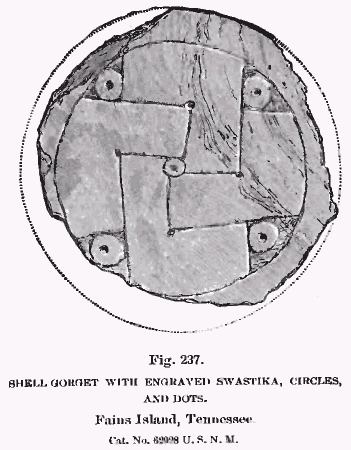

The Swastika
Dispersion of the Swastika
Skeleton No.
37. One polished stone chisel, one stone pipe, one shell
mask (ornamented).
41. One polished stone hatchet, one stone pipe, pottery
vase with ears (ornamented), one shell mask , one
shell pin, four arrowheads (two with serrated edges),
two stone perforators.
43. Lot of shell beads.
49. One polished stone hatchet, one spade-shaped stone
ornament (perforated), one spear-head, one stone pipe,
one pottery bowl with two handles, two shell masks
(ornamented), twenty-seven bone needles, two beaver
teeth, one bone implement (raccoon), piece of mica, lot
of red paint, two shell gorgets (one ornamented with
Swastika, fig. 238), thirty-six arrow-heads, lot of flint
chips, fragment of animal jaw and bones, lot of large
shells, one image pot.
51. One shell pin, one shell mask, one arrow-head, two small
shell beads.
52. One shell mask, one shell gorgot, one shell ornament.
These objects are now in the U. S. National Museum and in my department. The list is taken form the official catalogue, and they number from 115505 to
 115684.
I have had the opportunity of comparing the objects with this description
and find their general agreement. Dr. Palmer, the finder, was an employé
of the Bureau of Ethnology, is a man of the highest character, of great
zeal as an archæologist and naturalist, and has been for many years,
and is now, in the employ of the Bureau or Museum, always with satisfaction
and confidence. Mr. Emmert was also an employé of the Bureau for
many years, and equally reliable.
115684.
I have had the opportunity of comparing the objects with this description
and find their general agreement. Dr. Palmer, the finder, was an employé
of the Bureau of Ethnology, is a man of the highest character, of great
zeal as an archæologist and naturalist, and has been for many years,
and is now, in the employ of the Bureau or Museum, always with satisfaction
and confidence. Mr. Emmert was also an employé of the Bureau for
many years, and equally reliable. The specimens of shell in this and several other mounds, some of which are herein figured, were in an advanced stage of decay, pitted, discolored, and crumbling, requiring to be handled with the utmost care to prevent disintegration. They were dried by the collector, immersed in a weak solution of glue, and forwarded immediately (in 1885), with other relics from the neighborhood, to the Bureau of Ethnology and National Museum at Washington, where they have remained ever since. There is not the slightest suspicion concerning the genuineness or antiquity of this specimen or of those bearing the Swastika as belonging to the mound-building epoch in the valley of the Tennessee.
Other figures of sufficient similarity to the Swastika have been found among the aborigines of North America to show that these do not stand alone; and there are also other human figures which show a style of work so similar and such resemblance in detail of design as to establish the practical identity of their art. One of these was a remarkable specimen of engraved shell found in the same mound, Fains Island, which contained the first Swastika (fig. 237). It is described in the Second Annual Report of the Bureau of Ethnology, page 301, under the name of McMahon's mound. It is a large polished Fulgur shell disk which, when entire, has been nearly 5 inches in diameter (fig. 239). A little more than one-third has crumbled away, and the remaining portion has been preserved only by careful handling and immediate immersion in a solution of glue. It had been engraved on the concave side. The design represents two human figures plumed and winged, armed with eagles' talons and engaged in mortal combat. The design apparently covered the entire shell, leaving no space for encircling lines. The two figures are in profile and face each other in a fierce onset. Of the right-hand figure, only the body, one arm, and one leg remain. The left-hand figure is almost complete. The outline of the face, one arm, and one foot is all that is affected. The right hand is raised above the head in the act of brandishing a long knife pointed at both ends. The other combatant, clutching in his right hand a savage-looking blade with its point curved, seems delivering a blow in the face of his antagonist. Of the visible portions of the figures, the hands are vigorously drawn, the thumbs press down upon the outside of the forefingers in a natural effort to tighten the grasp. The body, arms, and legs are well defined and in proper proportion, the joints are correctly placed the left knee is bent forward, and the foot planted firmly on the ground, while the right is thrown gracefully back against the rim at the left, and the legs terminate in well-drawn eagles' feet armed with curved
<< Previous Page Next Page >>
© 2004-2007 Northvegr.
Most of the material on this site is in the public domain. However, many people have worked very hard to bring these texts to you so if you do use the work, we would appreciate it if you could give credit to both the Northvegr site and to the individuals who worked to bring you these texts. A small number of texts are copyrighted and cannot be used without the author's permission. Any text that is copyrighted will have a clear notation of such on the main index page for that text. Inquiries can be sent to info@northvegr.org. Northvegr™ and the Northvegr symbol are trademarks and service marks of the Northvegr Foundation.

|